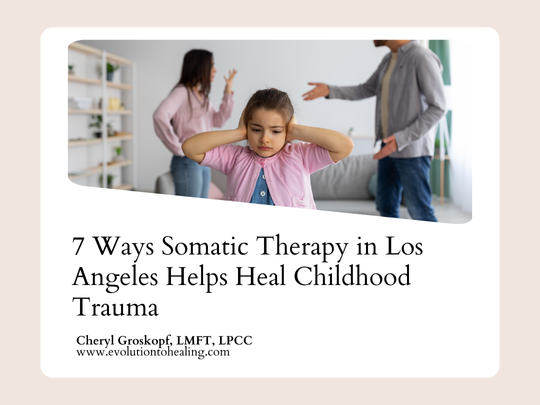You don’t outgrow childhood trauma just because you’ve gotten older. It lives in your body—tight shoulders, shallow breath, a constant need to overachieve or disappear. Somatic therapy helps with the part no one sees: the way your nervous system still reacts like it’s not safe. In my Los Angeles practice, I work with adults who’ve done all the talk therapy, all the self-help—and still feel stuck. This approach is different. It helps you reconnect with your body, process old pain without reliving it, and finally feel like you’re not just surviving anymore.

Cheryl Groskopf, LMFT, LPCC
Holistic anxiety, attachment, and trauma therapist in Los Angeles.
somatic therapy for childhood trauma in Los Angeles
How Somatic Therapy Helps You Heal Childhood Trauma (Without Reliving Every Detail)
Childhood trauma doesn’t just go away when you’re an adult. Instead, it gets stored in your body. It sticks around in your day-to-day life by manifesting as anxiety, insecurity, or even that feeling of just being “off.” Los Angeles is already overwhelming…adding the element of constantly scanning the environment for potential threats is just way too much.
Somatic therapy actually UNDERSTANDS this. As a somatic therapist in LA, I believe that your body should be actively involved in the healing process. Maybe you’ve tried talk therapy before, which just ran your thoughts and overthinking into the damn ground. If you’re tired of feeling like you’re constantly carrying the weight of your past, this could be the key to finally feeling lighter, more grounded – and like yourself again.
Here are 7 ways somatic therapy can help you reconnect with your body, calm your nervous system, and actually start healing from the inside out.

1. Reconnect With Your Body’s Signals
When you’ve been through childhood trauma, you become a master at ignoring your body. Tight shoulders? You power through. Clenched jaw? Must just be a bad day. But those aren’t random—they’re signals. Your body is trying to tell you something. And somatic therapy helps you actually listen.
Most of the clients I work with in my Los Angeles therapy practice have spent years overriding those cues. It’s not their fault—it was survival. But eventually, that disconnect turns into burnout, anxiety, and a body that never fully relaxes.
Somatic therapy helps you tune back in. You start noticing where tension lives in your body—and more importantly, you learn how to let it go.
How to Start Noticing Again: Body Scanning
Reconnection doesn’t happen overnight. But it starts with something simple: scanning your body from head to toe. Not to judge it. Not to fix it. Just to notice what’s there.
Pro tip: Try a quick scan when you’re in line at Trader Joe’s or stuck in traffic on the 405. Notice your jaw, your stomach, your chest. You don’t have to change anything yet. Just noticing is the beginning of healing.
Want more on nervous system patterns and how trauma shows up in the body? Read What Is Nervous System Dysregulation—and How Can Somatic Therapy Help?
trauma-informed therapy los angeles
2. Calm Your Nervous System
If you’ve lived with trauma, chances are you’ve also lived with a nervous system that is always hypervigilant. That’s what fight-or-flight feels like when it doesn’t reset.
Somatic therapy helps you shift out of survival mode by literally helping your body feel what safety actually is again. I use this with so many clients here in my practice who’ve done all the talking and still feel fried inside.
Why Nervous System Regulation Is Everything
Learning to regulate your nervous system isn’t a “nice to have”—it’s the foundation for real, long-lasting healing. It’s what allows your body to stop bracing, your mind to stop spinning, and your relationships to stop running on panic.
This is especially important for people dealing with complex trauma or anxiety that just won’t quit. When your system feels safe, everything else gets easier.
Grounding Techniques That Actually Work
You’ve probably heard “just breathe” more times than you can count. But this isn’t about some generic advice to chill out. It’s about using specific grounding techniques to tell your nervous system: you’re okay now.
Try this:
Inhale for four, hold for four, exhale for six.
Repeat a few rounds. Feel your feet on the ground. Let your jaw unclench.
This isn’t magic. But sometimes it feels pretty close.
Want the science behind this? The National Institute of Mental Health explains how trauma affects the body—and why nervous system work matters.

3. Break the Cycle of Repeating Trauma Patterns
Trauma has a sneaky way of leaking into every part of your life. You think you’ve moved on—and then you find yourself stuck in the same toxic relationship or reacting to a small conflict like it’s life or death. That’s because trauma isn’t just emotional—it’s physical. Your body learned how to survive, and it’s still running that same program until you teach it something new.
Somatic therapy works by interrupting those patterns. It helps your body release the survival energy it’s been holding for years so you can stop reacting like everything is a threat—even when it’s not.
For deeper body-based trauma work, I often integrate this with trauma therapy in Los Angeles to help clients understand both their triggers and the nervous system responses behind them.
Spot Your Triggers and Change Your Reactions
Recognizing your triggers is a good start. But somatic therapy goes deeper—it helps you notice what your body does in response. That’s where real change begins.
Pro tip: Keep a simple trigger journal. When something sets you off, jot down what happened and how your body responded—tight chest? Jaw locked? Shallow breath? Those physical cues are your roadmap for healing. They show you what your nervous system still thinks is dangerous.
somatic therapy for childhood trauma
4. Feel Your Emotions Without Drowning in Them
Ever notice how trauma makes you either feel everything all at once—or nothing at all? You’re either overwhelmed or completely numb. That’s not you being dramatic. That’s your nervous system doing what it learned to do.
Somatic therapy helps you find the space between those extremes. It teaches your body how to stay with emotion—without shutting down or getting hijacked by it. You’re not “losing control,” you’re learning to feel things safely.
This is especially powerful for clients working through attachment wounds, where emotions can feel chaotic or totally unreachable. When you’ve spent years adapting to stay safe in relationships, even having feelings can feel like a threat.
Feeling Your Emotions Without Overwhelm
Instead of letting emotions flood you—or trying to block them out—somatic therapy gives you tools to stay present. You start by noticing where the feeling shows up in your body: maybe your chest tightens, your throat closes, or your gut flips. And then you stay there—not to fix it, just to listen.
Reminder: Emotions aren’t permanent. They move.
When your body learns that it’s safe to feel without being consumed, the whole system recalibrates.

5. Heal the Root Cause, Not Just the Symptoms
So often, trauma healing gets reduced to symptom management. You’re told to journal more, sleep more, meditate more—anything to calm the anxiety, the mood swings, the total exhaustion.
But here’s the thing: if the trauma is still stuck in your body, no surface-level strategy is going to fix it. Somatic therapy helps you go deeper. You’re not just coping—you’re actually healing what’s underneath the anxiety or shutdown.
This is also what makes holistic therapy so powerful. Instead of treating symptoms in isolation, we work with the full picture—nervous system, emotional patterns, stored tension, and all the parts of you that learned to adapt in painful ways.
Getting to the Root Through Your Body
When trauma is stuck in the body, it shows up in ways that don’t always make sense—chronic stress, emotional reactivity, even physical symptoms. Somatic therapy helps you meet that trauma where it actually lives: in your breath, your posture, your gut, your muscles.
And yeah—this isn’t a quick fix. But it’s not supposed to be.
It’s about healing from the inside out so you don’t have to keep “managing” symptoms that were never random in the first place.
childhood trauma counseling
6. Build Emotional and Physical Resilience
Over time, my clients start to notice something subtle but powerful:
Stressful things still happen—but your body doesn’t immediately brace, shut down, or go into panic mode. You stay more grounded. More present. Less thrown off course.
Strengthen Your Emotional Toolbox
Somatic therapy gives you tools that aren’t just “coping skills.” These are body-based strategies—like grounding, breathwork, and somatic tracking—that help your nervous system regulate in real time.
And the more your body practices staying present, the easier it gets.
You start to trust yourself again.
Pro tip: The goal isn’t perfection—it’s capacity.
Every time you manage a tough conversation or a stressful day without spiraling? That’s your nervous system healing in real life.

7. Reconnect With Yourself
Trauma disconnects you. From people. From your emotions. From yourself. And after a while, it starts to feel normal—like the numbness, the second-guessing, the constant bracing is just who you are now.
But it’s not.
Somatic therapy helps you rebuild that connection piece by piece. You start to feel more grounded in your body. More in touch with what you want. More like the version of you that existed before trauma taught you to shut down just to stay safe.
Healing Isn’t Linear—And That’s Okay
Reconnecting with yourself takes time. You’re not going to wake up one day fully healed. Some days you’ll feel strong. Some days you’ll want to crawl back into your shell. Both are part of the process.
Reminder: Progress doesn’t always look like progress.
But every time you choose to stay with yourself instead of abandoning your needs? That’s healing.
If this resonates, reach out here to explore somatic therapy that’s grounded, nervous system-informed, and actually built for what you’ve lived through.
Work with Cheryl Groskopf, LMFT, LPCC
Hi, I’m Cheryl Groskopf—a holistic licensed Marriage and Family Therapist based in Los Angeles. I specialize in working with high-functioning, emotionally curious adults who feel stuck in anxiety, trauma patterns, or attachment dynamics they can’t think their way out of.
My approach blends body-based healing with IFS (Internal Family Systems), nervous system work, and emotional processing that actually goes somewhere. That means I don’t just help you understand why you feel the way you do—I help you build a relationship with the parts of you that learned to overfunction, shut down, or keep performing just to stay safe.
Many of my clients grew up in emotionally unavailable or unpredictable homes, and those early dynamics show up in the present—especially in relationships. My job is to help you break that cycle. To come back to yourself. To stop abandoning your needs the moment things get hard.
Want to learn more about how I blend body-based therapy with parts work and holistic support? Start here.
Related Blog Posts on Somatic Therapy and Trauma Healing
If you're exploring how trauma shows up in your body or why you still feel stuck even after years of therapy, these posts go deeper into the healing process—nervous system, emotions, and all:
- 10 Signs Your Body Is Still Holding Onto Trauma – Learn the subtle ways unresolved trauma lingers—and how to start releasing it.
- What Most People Get Wrong About Complex PTSD – A breakdown of misunderstood symptoms, nervous system reactions, and how real healing begins.
- Understanding Trauma Responses and How Therapy Can Help – Fight, flight, freeze, fawn—this blog unpacks how your body learned to survive and what to do next.
- 10 Things I Wish More People Knew About Somatic Therapy – A practical, body-first lens on healing trauma, anxiety, and emotional overwhelm.
Somatic Therapy in Los Angeles—Serving Clients Across California
I’m based in West LA at 1849 Sawtelle Blvd, Suite #610, just off the 405. I work with clients all over Los Angeles—from Santa Monica to Echo Park and beyond. While my practice is primarily online, this is where I’m grounded. If you're searching for somatic therapy near you or nervous system-based trauma healing in Los Angeles, you're in the right place.
Ready to Stop Surviving and Start Feeling Like Yourself Again?
Trauma doesn’t just affect your thoughts—it settles into your body. That’s why talk therapy alone often doesn’t cut it. Somatic therapy in Los Angeles helps you release what’s still stuck in your nervous system so you can stop living in survival mode and start feeling like you again.
In our work together, we’ll explore how your body has been holding onto the past—and how to gently release the tension, stress, and emotional weight it’s been carrying for years. We’ll use tools like breathwork, nervous system regulation, and real self-reflection to help you create lasting change.
Whether you’re navigating complex trauma, anxiety, or attachment challenges, this is a space where all parts of you are welcome. You don’t have to power through anymore.
Reach out here when you’re ready. I’d be honored to support you on this next chapter of your healing.




